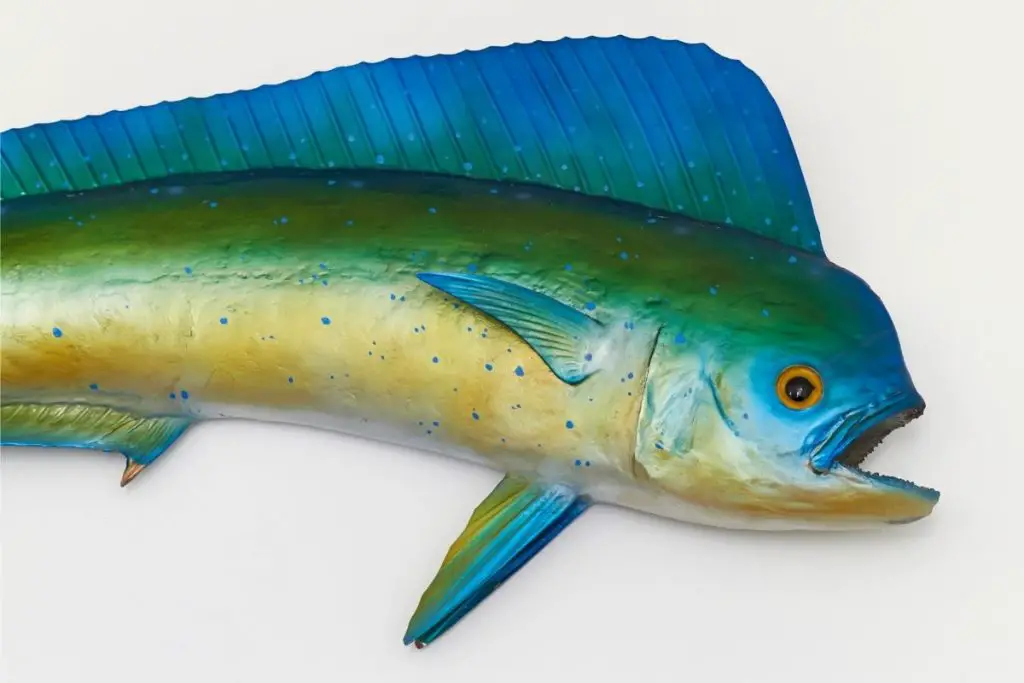The name mahi-mahi has a pleasing sound to it – it rolls off the tongue nicely and sounds kind of tropical. But what kind of fish is it?
That is exactly the question we’re going to answer in this article so by the end, you’ll know everything you need to know about mahi-mahi!
This will include where its name comes from, where they live, what they’re like, their scientific classification, and more. So, without further ado, let’s get into it.
Where Does The Name Mahi-Mahi Come From?
The name mahi-mahi comes from the Hawaiian language. In Hawaiian, the word “mahi” means strong, and repeating it increases the emphasis.
Therefore, the name “mahi-mahi” means “very strong”. Coincidentally, the Persian word “mahi” means fish, but there is no connection between the name and Persia.
However, the fish is also sometimes known by several other names.
These include the dorado, which can be confusing because another, freshwater fish, is also sometimes known either as the dorado or the golden dorado.
Another name it goes by is the common dolphin fish or even just dolphin. Naturally, this can cause confusion with dolphins as in the aquatic mammals.
People are sometimes shocked to see billboards and posters offering “dolphin fishing” in Florida, but these refer to mahi-mahi, not real dolphins!
Where Do Mahi-Mahi Live?
Mahi-Mahi can be found in many tropical, subtropical, and temperate waters worldwide, including the Atlantic, Pacific, and Indian oceans.
They gather in large numbers in the Gulf of Mexico and in the waters near Florida, and these are popular fishing destinations for people looking to catch mahi-mahi.
What Are Mahi-Mahi Like?
The first thing you might notice about a mahi-mahi if you see one is the color. Their scales are a dazzling mixture of blue, green and gold, which is one of the reasons that they’re a popular fish to catch for sport.
They also often change color and seem to glimmer when out of the water.
You can also identify them by the bony crests they have on the front of their heads, their dorsal fins (which run from their eyes to the caudal fin), and an unusually long pectoral fin which runs more than half the head’s length.
The average adult mahi-mahi weighs between 15 and 30 pounds. A mahi-mahi that weighs over 40 pounds is generally considered a good prize fish in sports fishing circles.
The largest mahi-mahi on record weighed an enormous 87 pounds, and was caught in Costa Rica in 1976. They can live for five years, although it is not common for them to live beyond four years of age.
Mahi-mahi are notable for growing very quickly and can reach sexual maturity in as little as four or five months. The female of the species usually reaches a smaller size than the male.
They are carnivorous fish and mostly survive by preying on other sea creatures, such as flying fish, mackerel, and squid. They, in turn, are targeted by larger predators such as tuna, swordfish, and marine mammals.
Mahi-Mahi Taxonomy And Classification
Mahi-Mahi are part of a class called actinopterygii. Members of this class are also called “ray-finned fishes”, and include almost 99% of all fish.
Getting more specific, they’re part of the order called carangiformes, the family coryphaenidae, and the genus coryphaena (which is currently the only known genus in the family coryphaenidae).
This genus’ members are sometimes collectively known as the dolphin fishes (which is a name that’s also sometimes used for the mahi-mahi specifically).
The mahi-mahi is one of only two species currently recognized as being part of this genus.
The other one is the pompano dolphinfish, which lives in the waters around South America.
They are somewhat smaller than mahi-mahi but are sometimes mistaken for juvenile specimens of mahi-mahi.
As A Sport Fish
Mahi-mahi are commonly fished for sport. Their large numbers and dazzling colors contribute to this, but another advantage is that they can often be found near the surface of the water, meaning that it’s not too hard to find them.
They’re typically attracted by floating objects on the water, and waiting close to some of these is a common method that’s used when fishing for mahi-mahi.
Some people also like to catch mahi-mahi out at sea by trolling. One other reason that you might want to catch mahi-mahi is to eat them, which leads us onto our next section.
As Food
Mahi-mahi make for a good meal, although for a long time they were just considered a bycatch by people fishing for tuna and swordfish.
They’re now commonly sought in their own right, however. They are widely eaten in the Caribbean and certain parts of the United States, although they’re starting to become more popular elsewhere as well.
They are typically hunted for food with harpoons in French Polynesia and the Philippines.
Mahi-mahi flesh is an eye-pleasing white color when it’s cooked, and has a clean, fresh taste that’s usually described as not overly fishy, but mildly sweet.
The meat has a firm texture and breaks into large flakes. Due to that firm texture, it makes a good choice of fish for grilling since it can be relied upon not to break into pieces on the grill.
Grilling’s far from the only way to enjoy it, though, as it’s a very versatile fish. It can instead be poached, baked, steamed, fried or pretty much any other cooking method that you’d like to try.
It also works well with all kinds of different flavor profiles, from lemon to chili to soy sauce.
When caught in the US, mahi-mahi is a pretty environmentally healthy fish option since it’s sustainably managed and responsibly fished.
Final Thoughts
So, there you have it, everything you need to know about the mahi-mahi and what kind of fish it is.
Whether you’re looking to catch some mahi-mahi for yourself or are just interested in buying some to eat, it’s becoming easier and easier to do these days, so do a little research in your local area to see what’s available.



